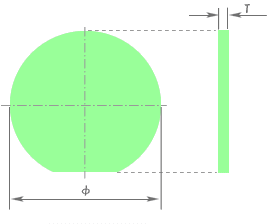|
©2021 Optostar Ltd. All Rights Reserved |
|
 |
|
UV-grade synthetic fused-silica wafers
Transmission wavelengths (Over 80percent):
180 - 2000nm
Standard diameters:
2-, 3-, 4-, 6-, and 8-inch wafers/Squared shapes
Standard thickness:
0.3mm to 1.0mm (Special thin thickness to 0.1mm)
Polishing: Nominal double side polished
(Surface quality: According to MIL-SPEC standards)
Standard edge shape: U-shape
Primary flatness: With or without
Ra: < 12A
TTV and BowF < 10micron (Depend on specs)
Using ultrasonic cleaning system
Packing in plastic boxes, 25pcs per box, upon request.
Mass production is available
(Quantities of thousands of polished wafers per month)
(*)The above descriptions are typical ones and will not be necessarily
covered by each contract.
|
|
|
|
|
|
|
|
|
|
|
|
|
|
 Back Back |
|
|
|
|
|
|

Glass and fused-silica wafers are used by many universities, research institutes, and high-technology companies not only in Japan, but also globally. We can easily customize our standard glass- and fused-silica wafer products to meet the most demanding specialized specifications. Our minimum sales order is 10 pieces (20 pieces for polished-glass wafers). For exact quotations, please send your inquiries by e-mail.
Small-lot custom orders for various shapes of fused-silica wafers
What are the main differences between fused-quartz and fused-silica substrate?
Historically, quartz glass was produced by melting natural quartz crystal at very high temperatures. Today, quartz glass is manufactured from quartz crystal powders or from SiCl4: the former is called "fused quartz" and the latter "synthetic fused silica."
In general, the process for making fused quartz material costs a little less than that for fused silica. However, its material purity is also lower, making its applications limited to lower precision of optical components, while fused-silica material is used for high-precision optical applications such as fiber optical components or products.
Thus, we recommend polished fused-silica substrates for use in optical,
electronic, photonic, semiconductor, and MEMS applications: these bring
you a much better cost-to-performance for your production or research/development
process. If you see bubbles or other contamination problems in your glass
substrates, using high-purity fused silica substrates could be your best
solution.

